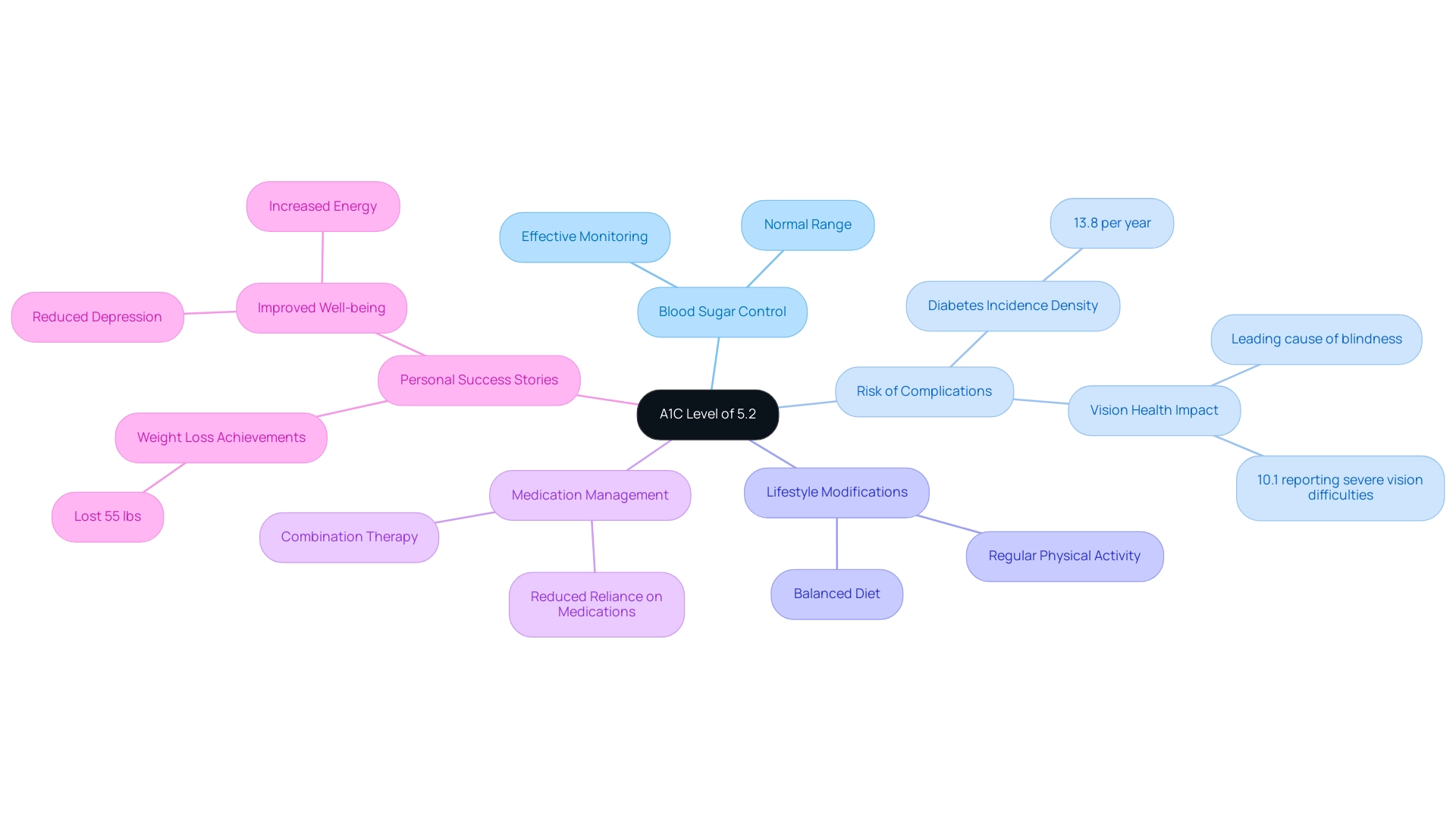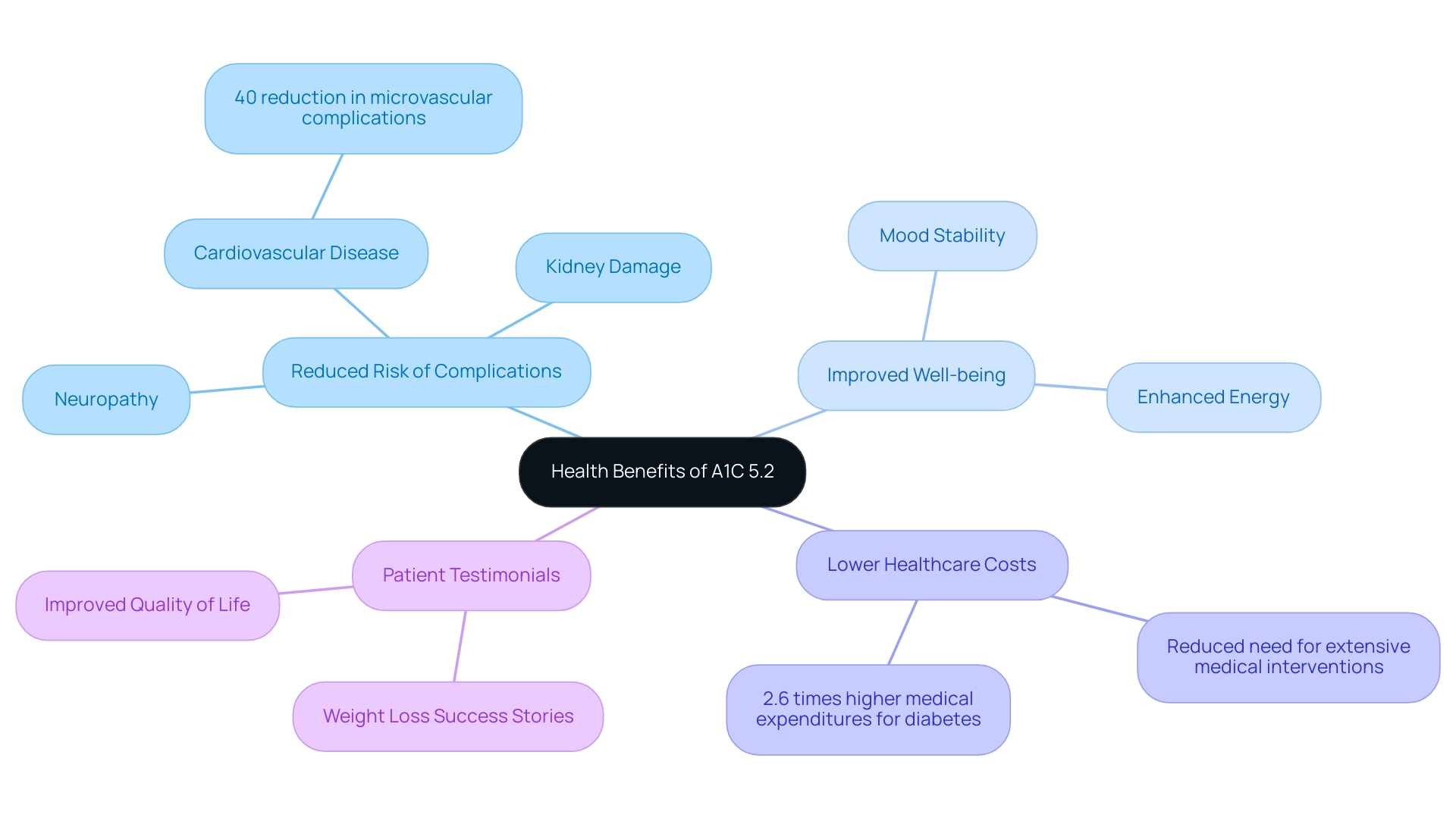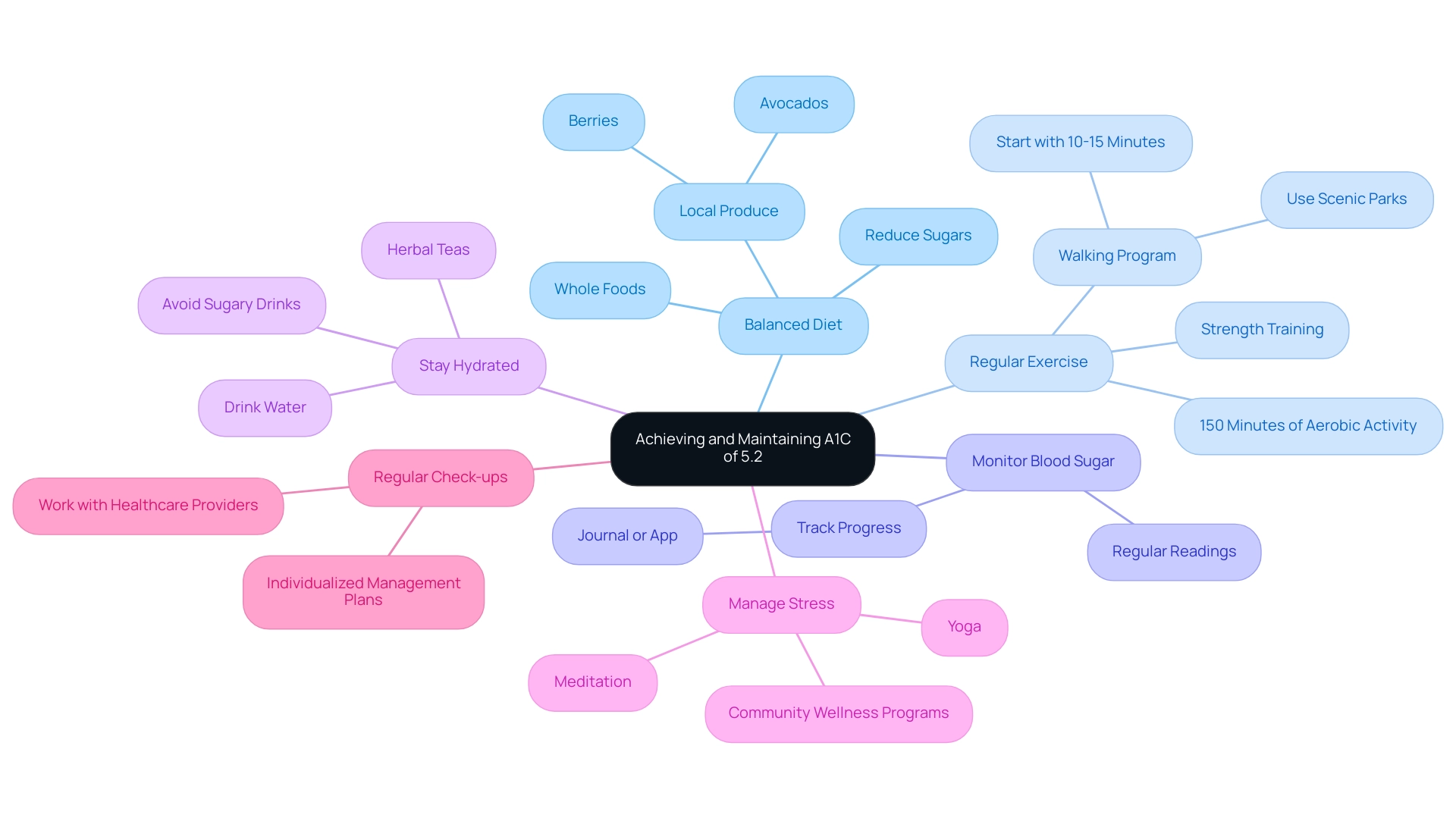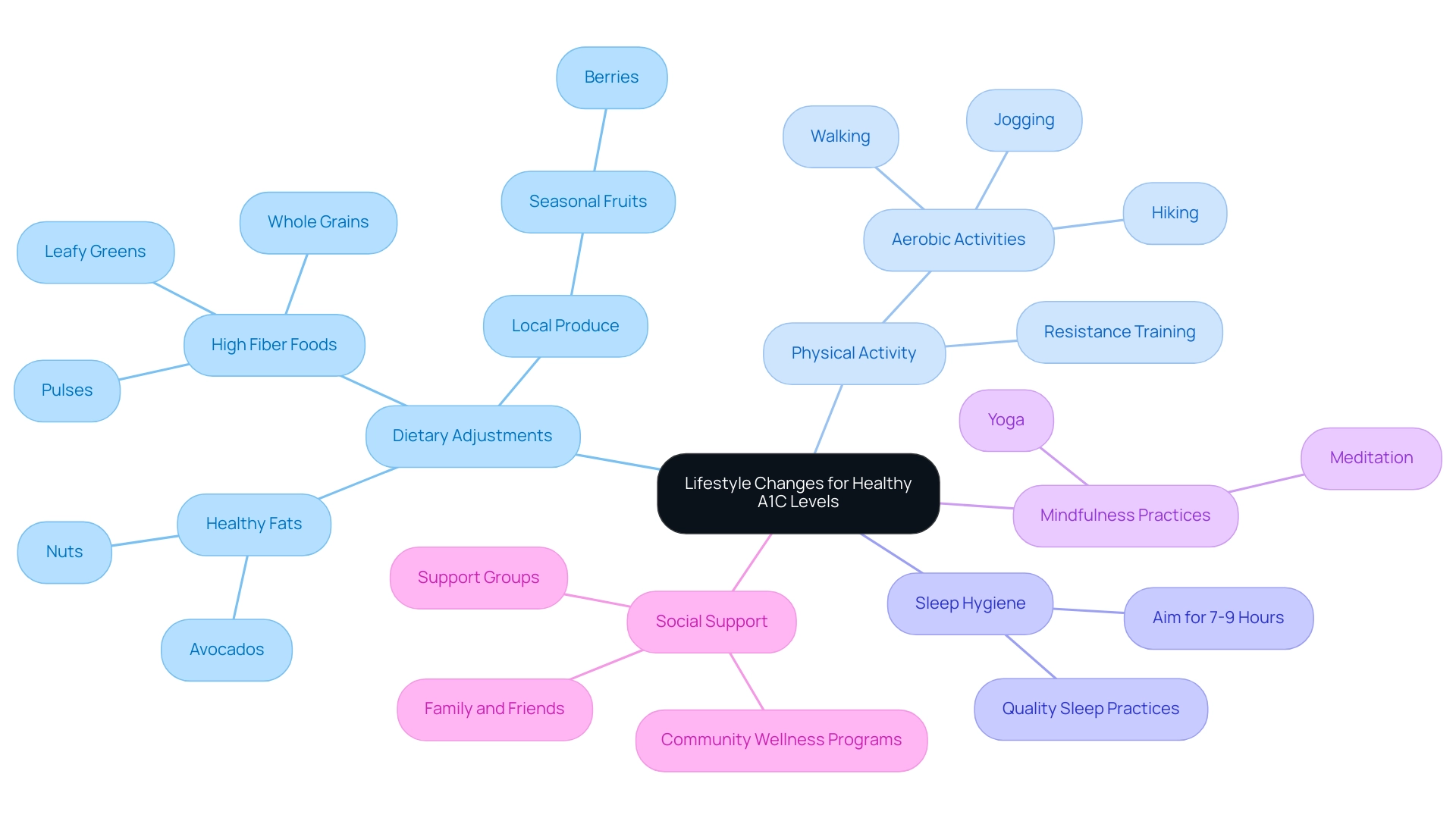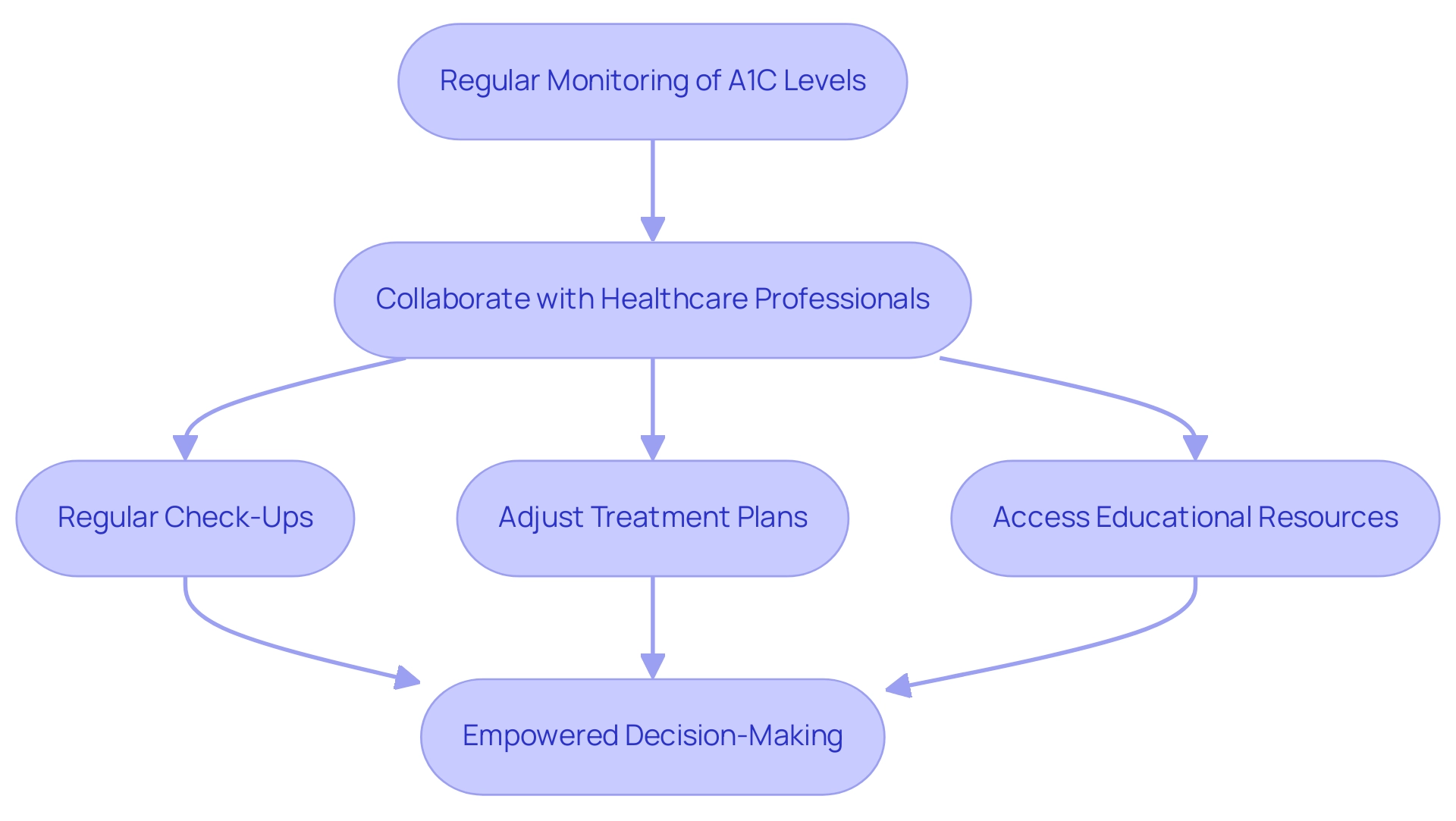Overview
An A1C of 5.2 is truly a positive milestone. It reflects effective blood sugar management, which can significantly lower the risk of diabetes-related complications. It’s important to recognize that maintaining an A1C below 5.7% is associated with better health outcomes. Many patients find that this leads to a reduced incidence of serious conditions, such as cardiovascular disease, and enhances overall well-being through lifestyle modifications and personalized health strategies.
Have you considered how small changes can lead to such impactful results? Embracing a healthier lifestyle can be both empowering and rewarding. By focusing on your health, you not only improve your A1C but also invest in a brighter, healthier future for yourself.
Introduction
In the realm of diabetes management, understanding A1C levels is essential for individuals striving for optimal health. Have you ever wondered how your A1C test results reflect your journey? This vital test not only indicates your average blood sugar levels over the past two to three months but also carries profound significance beyond mere numbers. With diabetes rates on the rise, particularly among adolescents, grasping the implications of A1C readings can empower you to take charge of your health.
It’s important to recognize that a lower A1C percentage signifies better blood sugar control and plays a crucial role in preventing serious complications associated with diabetes. Many patients find that through real-life success stories and expert insights, they can see the transformative power of achieving and maintaining an A1C of 5.2. Imagine how lifestyle changes and proactive healthcare collaboration can lead to improved well-being and a brighter future. Together, we can navigate this journey toward better health.
Understanding A1C: What It Is and Why It Matters
The A1C test, often referred to as the hemoglobin A1C test, plays a crucial role in managing blood sugar by assessing average glucose levels over the past two to three months. This essential test measures the percentage of glucose attached to hemoglobin, the protein in red blood cells responsible for transporting oxygen. A lower A1C percentage signifies better blood sugar control, which is vital for preventing the numerous complications associated with diabetes.
Understanding A1C readings is important for individuals managing their condition, as it provides a comprehensive overview of long-term glucose levels, influencing treatment choices and lifestyle adjustments. An A1C level below 5.7% is considered normal, while levels between 5.7% and 6.4% indicate prediabetes. A diagnosis of diabetes is confirmed with an A1C of 6.5% or higher.
When reflecting on health indicators, one might wonder, is 5.2 a good A1C? This level not only suggests good health but also indicates effective blood sugar management strategies.
Current statistics show a concerning rise in type 2 diabetes among youth, with 5,293 children and adolescents aged 10 to 19 diagnosed. Additionally, there are alarming figures of 7,000 incorrect medications administered in hospitals and 80,000 infections acquired, underscoring the importance of regular A1C testing as a proactive measure in diabetes care. Dr. Jason Shumard emphasizes, “By providing individuals with actionable insights and practical tools, the Integrative Wellness Center fosters an environment where people can reclaim their health and well-being, ultimately leading to improved quality of life and reduced reliance on conventional medical interventions.”
Case studies from individuals at the Integrative Wellness Center illustrate the transformative power of understanding A1C levels. One individual shared, “I was on two different meds that weren’t working and was told that I needed insulin. After joining this program, I lost 55 lbs, and my A1C dropped from 9.1 to 5.7!”
Another patient remarked, “I’ve had this condition for fourteen years and was taking many drugs. Now, I feel so much better and don’t need my meds anymore!” These testimonials highlight the life-changing outcomes achieved through personalized programs that emphasize education and empowerment.
Expert opinions further reinforce the significance of A1C testing in managing blood sugar levels. Endocrinologists assert that maintaining A1C values below 7% can significantly reduce the risk of complications, while always prioritizing individual safety. As we look ahead to 2025, the importance of A1C measurements in managing glucose conditions remains a central topic in healthcare discussions, with real-world examples demonstrating how these readings directly influence treatment choices and patient outcomes.
By fostering an environment where individuals can reclaim their health, the Integrative Wellness Center exemplifies a holistic approach to managing diabetes, leading to improved quality of life and reduced dependence on conventional medical interventions.
What Does an A1C of 5.2 Indicate About Your Health?
An A1C measurement of 5.2 indicates that 5.2% of hemoglobin in the blood is glycated, leading to the question: is 5.2 a good A1C? This stage is well within the normal range, suggesting that the individual maintains good blood sugar control and is at a significantly lower risk for diabetes-related complications. For those with a history of this condition, the inquiry of whether 5.2 is a good A1C serves as a strong indicator of effective management, whether through lifestyle modifications, medication, or a combination of both.
It’s important to recognize that this stage reflects a proactive approach to health. It suggests that the individual is likely adhering to a balanced diet, engaging in regular physical activity, and effectively monitoring their blood sugar levels. The significance of sustaining such an A1C level cannot be overstated; studies suggest that the incidence density of the condition is approximately 13.8% per year, highlighting the essential need for effective management strategies.
Moreover, achieving an A1C of 5.2 raises an important question: is 5.2 a good A1C associated with improved health outcomes? For instance, diabetes is the leading cause of new cases of blindness among adults aged 18–64, with 10.1% of diagnosed adults reporting severe vision difficulties or blindness in 2021. This underscores the importance of early intervention and ongoing management to prevent severe complications.
As Dr. Jason Shumard emphasizes, “By providing individuals with actionable insights and practical tools, the center fosters an environment where they can reclaim their health and well-being.”
Success stories abound among individuals who have achieved an A1C of 5.2, prompting the question, is 5.2 a good A1C, and showcasing the transformative impact of Dr. Jason Shumard’s 30-Day Diabetes Reset Program. One individual shared, “I lost 55 lbs. My A1C started at 9.1; after 8 months, it is now 5.7.”
Another noted, “I feel so much better… I lost a lot of weight, have more energy, and feel great. I am not depressed anymore, and I don’t need my meds anymore!!!”
These testimonials highlight the program’s effectiveness in not only managing health conditions but also enhancing overall well-being.
This holistic approach not only manages symptoms but also improves patients’ quality of life and reduces reliance on conventional medical interventions, ultimately leading to better health outcomes and a brighter future. By prioritizing goal-setting and consistent progress tracking, such as utilizing fitness apps and setting SMART goals, participants can cultivate a sense of achievement, maintain engagement in their health journey, and empower themselves in their diabetes management.
Health Benefits of Achieving an A1C of 5.2
Maintaining an A1C of 5.2 raises an important question: is 5.2 a good A1C? This level offers a multitude of health benefits, particularly in reducing the risk of diabetes-related complications. Research shows that individuals with lower A1C values experience a significantly decreased incidence of serious conditions such as cardiovascular disease, kidney damage, and neuropathy. For instance, studies indicate that for every 1% reduction in A1C, the risk of microvascular complications can be reduced by approximately 40%.
Many individuals who achieve an A1C of 5.2 often wonder, is 5.2 a good A1C? They report enhanced energy, improved mood stability, and an overall boost in well-being. This level of glycemic control not only contributes to better physical health but also translates into lower healthcare costs. In fact, average medical expenditures among individuals with diagnosed high blood sugar levels are 2.6 times higher than those without the condition.
With fewer complications arising from diabetes, there is a reduced need for extensive medical interventions, which can be financially burdensome. Dr. Jason Shumard’s 30-Day Diabetes Reset program at Integrative Wellness Center has been instrumental in helping individuals achieve these results. One participant shared, “I lost 55 lbs. My A1C started at 9.1; after 8 months, it is now 5.7.”
Another individual noted, “I feel so much better… I lost a lot of weight, have more energy, and feel great. I am not depressed anymore and I don’t need my meds anymore!” These testimonials highlight the transformative impact of the program on individuals’ lives, showcasing how personalized functional medicine strategies empower people to manage their diabetes effectively.
To understand if 5.2 is a good A1C, it is crucial to target postprandial glucose levels to less than 180 mg/dL (10.0 mmol/L) in order to achieve and maintain that level. The empowerment that comes from achieving and maintaining an A1C of 5.2 raises the question: is 5.2 a good A1C? Patients frequently express a sense of accomplishment that motivates them to adopt and sustain healthy lifestyle practices.
Dr. Jason Shumard emphasizes, “By providing patients with actionable insights and practical tools, the Integrative Wellness Center fosters an environment where individuals can reclaim their health and well-being, ultimately leading to improved quality of life and reduced reliance on conventional medical interventions.” Real-life examples illustrate this point: individuals who have successfully maintained an A1C of 5.2 often ask, ‘is 5.2 a good A1C?’ They report fewer hospital visits and a greater ability to manage their diabetes effectively.
In summary, the health advantages of keeping A1C readings below 5.7 are substantial, with statistics demonstrating a clear correlation between lower A1C figures and reduced risk of complications. The case study titled “Glucose Assessment in Diabetes Management” highlights the importance of glucose monitoring in achieving glycemic targets, further supporting the narrative about whether 5.2 is a good A1C. As the healthcare landscape continues to evolve, the emphasis on personalized care and education remains crucial in helping individuals reclaim their health and improve their quality of life.
How to Achieve and Maintain an A1C of 5.2: Practical Tips
To determine if 5.2 is a good A1C, it’s important to recognize the journey you’re on. Achieving and maintaining this level requires a multifaceted strategy that includes various lifestyle changes. Here are several practical tips to consider:
-
Balanced Diet: Prioritize a diet rich in whole foods, such as fresh vegetables, lean proteins, and whole grains. Reducing processed foods and sugars is crucial for effective blood sugar management. The UKPDS trial highlights that maintaining an A1C level of 5.2 can significantly reduce the risk of diabetes-related complications, underscoring the importance of your dietary choices. Embrace local produce available at farmers’ markets in San Marcos, like avocados and berries, to enhance your meals with nutritious options.
-
Regular Exercise: Aim for at least 150 minutes of moderate aerobic activity each week, complemented by strength training exercises. This combination not only aids in weight management but also enhances insulin sensitivity. Many patients find that starting a walking program, assessing their current fitness, and setting realistic goals—like a daily walk of 10-15 minutes—can be very effective. For detailed guidance, refer to the walking program PDF available at the Integrative Wellness Center. Engaging with the scenic parks and trails in San Marcos can make this routine enjoyable and sustainable.
-
Monitor Blood Sugar: Consistently checking your blood glucose readings is essential to understand how different foods and activities influence your A1C. This practice empowers you to make informed dietary and lifestyle choices. Tracking your progress through a journal or app can help maintain motivation and celebrate your achievements along the way.
-
Stay Hydrated: Sufficient hydration is crucial for regulating blood sugar concentrations. Drinking plenty of water can help maintain optimal bodily functions and support overall health. Opt for water or herbal teas instead of sugary drinks to help maintain proper hydration without impacting blood sugar levels.
-
Manage Stress: Incorporating stress-reducing techniques such as yoga, meditation, or deep-breathing exercises can significantly impact blood sugar control. Participating in community wellness programs in San Marcos, like those available at local centers, can offer invaluable support and resources customized for managing health conditions while enjoying the beautiful surroundings. Remember, stress management is a key component of diabetes care.
-
Regular Check-ups: It’s essential to work closely with your healthcare providers to monitor A1C readings and evaluate if 5.2 is a good A1C, adjusting treatment plans as necessary. Regular consultations ensure that any necessary changes to your management strategy are made promptly. The VA/DoD guidelines advocate for individualized glycemic management plans, emphasizing the importance of considering your characteristics and preferences in setting appropriate A1C targets.
By applying these strategies, you can effectively manage your diabetes and maintain a healthy A1C. Real-world examples show that those who adopt a balanced diet and consistent exercise regimen often achieve significant improvements in their A1C results. Furthermore, expert advice underscores the importance of lifestyle changes in achieving optimal A1C control.
As Dr. Jason Shumard states, “By providing patients with actionable insights and practical tools, the center fosters an environment where individuals can reclaim their health and well-being.” This proactive approach can lead to lasting health benefits, especially in light of findings from the VADT trial, which indicate that intensive therapy may not always yield better outcomes compared to standard therapy.
Lifestyle Changes to Support a Healthy A1C Level
Lifestyle changes are essential for maintaining a healthy A1C measurement, and several key adjustments can significantly influence outcomes.
-
Dietary Adjustments: It’s important to recognize that a diet rich in fiber, low in refined carbohydrates, and abundant in healthy fats is crucial. Including foods like leafy greens, nuts, and whole grains can effectively stabilize blood sugar. In San Marcos, vibrant farmers’ markets offer a rich variety of fresh, local produce perfect for a diabetes-friendly diet. Seasonal fruits like avocados and berries, along with vegetables such as leafy greens, are high in fiber and essential nutrients, which help regulate blood sugar levels. Current nutrition guidelines emphasize the significance of sufficient dietary fiber consumption from vegetables, pulses, whole fruits, and whole grains for individuals with blood sugar concerns. Research indicates that higher dietary fiber intake is strongly associated with reductions in markers for heart and kidney disease. As noted by Derek Miketinas, PhD, RD, “our preliminary analysis suggests that higher dietary fiber intake in adults with diabetes is strongly associated with reductions in markers for heart and kidney disease,” underscoring the importance of these dietary choices. Additionally, Dr. Shumard offers comprehensive nutrition plans tailored to individual needs, ensuring that patients receive personalized guidance in their dietary choices.
-
Physical Activity: Many patients find that participating in regular exercise not only reduces blood sugar amounts but also improves insulin sensitivity. In San Marcos, the area’s scenic parks and trails provide perfect opportunities for outdoor activities like walking, jogging, or hiking. A combination of aerobic activities and resistance training can yield the best results. Studies indicate that consistent physical activity can result in significant enhancements in A1C measurements, leading to the consideration of whether 5.2 is a good A1C for effective diabetes management. In a study involving 293 subjects, lifestyle changes, including increased physical activity, were demonstrated to correlate with improved A1C values, leading to the inquiry of whether 5.2 is a good A1C.
-
Sleep Hygiene: Quality sleep is often overlooked but plays a critical role in blood sugar control. Poor sleep can result in insulin resistance and increased blood sugar amounts. Aim for 7-9 hours of restful sleep each night to support overall health and metabolic function.
-
Mindfulness Practices: It’s crucial to acknowledge that stress management is vital, as stress can adversely affect blood sugar levels. Engaging in mindfulness or relaxation techniques, such as meditation or yoga, can help mitigate stress and promote better blood sugar control. San Marcos offers numerous opportunities to practice mindfulness, with local studios and community centers providing classes that can enhance your well-being. Integrating these practices into your routine can significantly enhance your overall health and management of blood sugar.
-
Social Support: Building a supportive community is vital for maintaining motivation and accountability in your health journey. Whether through family, friends, or support groups for health conditions, having a network can provide encouragement and shared experiences that enhance your commitment to lifestyle changes. Getting involved in community wellness programs in San Marcos can provide invaluable support for managing type 2 diabetes, offering personalized advice and resources tailored to your needs. Testimonials from individuals who have successfully adopted these lifestyle modifications can serve as strong motivators, demonstrating the effectiveness of dietary changes and enhanced physical activity in improving A1C values.
Real-world examples illustrate the effectiveness of these lifestyle changes. Patients who have embraced dietary adjustments and increased physical activity often report significant improvements in their A1C results, which leads to the consideration of whether 5.2 is a good A1C for better overall health outcomes. Dr. Shumard’s educational resources, including seminars and personalized nutrition plans, empower individuals with the knowledge needed to implement these changes effectively, fostering an environment where they can reclaim their health and well-being.
The Importance of Regular Monitoring and Healthcare Collaboration
Regular monitoring of A1C levels is crucial for effectively managing your health. It helps you determine if 5.2 is a good A1C and make informed decisions about your well-being. It’s important to recognize that this proactive approach is vital, especially given the alarming statistics regarding hospital safety—like the 7,000 incorrect medications administered and 80,000 infections contracted in hospitals. These concerns highlight the need for a more individualized and comprehensive strategy in managing your condition.
Cooperating with healthcare professionals can significantly enhance this process. By working together, you ensure that you receive personalized care that addresses the underlying factors affecting your health. This collaboration includes:
- Regular check-ups
- Adjustments to treatment plans
- Access to educational resources that empower you
Dr. Jason Shumard’s Functional Medicine Approach is a great example of this, as he emphasizes reversing type 2 diabetes through personalized guidance and comprehensive testing, leading to transformative experiences for many individuals.
Healthcare professionals play a vital role in keeping you informed about the latest research and advancements in diabetes management. This knowledge helps you understand if 5.2 is a good A1C for you. Many patients find that coordinated efforts between themselves and their healthcare teams lead to improved A1C management, ultimately enhancing their quality of life. They often report life-changing outcomes and express gratitude for the empowerment they feel in managing their health through Dr. Shumard’s holistic solutions, frequently questioning if 5.2 is a good A1C. By fostering a strong partnership with your healthcare providers, you can significantly improve your ability to maintain healthy A1C levels, leading to better overall health outcomes and a reduced reliance on conventional medical interventions.
This holistic approach not only addresses the symptoms of your condition but also targets the underlying causes, empowering you to reclaim your health and well-being. As P.M.N. emphasizes, having full access to data and understanding its integrity is crucial for informed decision-making in diabetes management. This further underscores the importance of collaboration and education on your journey to better health.
Conclusion
Achieving and maintaining an A1C level of 5.2 is a significant milestone in diabetes management. It reflects effective blood sugar control and a lower risk of complications. This level not only indicates good health but also showcases the power of lifestyle changes, regular monitoring, and proactive healthcare collaboration. Many patients find that adopting a balanced diet, engaging in regular exercise, and prioritizing stress management can lead to transformative health benefits.
Real-life success stories from patients underscore the importance of personalized programs and the profound impact of understanding A1C levels on overall well-being. By emphasizing education and empowerment, individuals can reclaim their health and improve their quality of life, reducing reliance on conventional medical interventions. It’s important to recognize that the role of healthcare providers in guiding patients through this journey cannot be overstated. Their expertise and support are essential in developing tailored strategies that address the unique needs of each individual.
In conclusion, the pathway to a healthier life through effective diabetes management is illuminated by the understanding of A1C levels. By committing to lifestyle changes, leveraging expert insights, and fostering strong healthcare partnerships, individuals can achieve not only an optimal A1C but also a brighter, healthier future. The journey towards better health is within reach. Together, the collective efforts of patients and healthcare teams can lead to lasting improvements in diabetes care.
Frequently Asked Questions
What is the A1C test and why is it important?
The A1C test, also known as the hemoglobin A1C test, measures the average glucose levels in the blood over the past two to three months. It is crucial for managing blood sugar as it helps assess long-term glucose control, which is vital in preventing complications associated with diabetes.
What do the A1C readings indicate?
A normal A1C level is below 5.7%. Levels between 5.7% and 6.4% indicate prediabetes, while an A1C of 6.5% or higher confirms a diagnosis of diabetes. A lower A1C percentage signifies better blood sugar control.
Is an A1C level of 5.2 considered good?
Yes, an A1C level of 5.2 is well within the normal range, indicating effective blood sugar management and a significantly lower risk for diabetes-related complications.
What lifestyle factors contribute to maintaining a good A1C level?
Maintaining a good A1C level suggests adherence to a balanced diet, regular physical activity, and effective monitoring of blood sugar levels.
How does A1C testing relate to diabetes complications?
Regular A1C testing is essential as it helps in the early intervention and ongoing management of diabetes, which can prevent severe complications such as vision difficulties or blindness.
What are some success stories related to A1C management?
Individuals have reported significant improvements in their health after participating in programs focused on A1C management. For example, one person lost 55 lbs and decreased their A1C from 9.1 to 5.7, while another noted feeling better and no longer needing medications.
What is the significance of maintaining an A1C level below 7%?
Endocrinologists recommend maintaining A1C values below 7% to significantly reduce the risk of diabetes-related complications, emphasizing the importance of regular monitoring and management.
How does the Integrative Wellness Center approach diabetes management?
The Integrative Wellness Center adopts a holistic approach to managing diabetes by providing actionable insights and practical tools, fostering an environment for individuals to reclaim their health and improve their quality of life while reducing reliance on conventional medical interventions.

